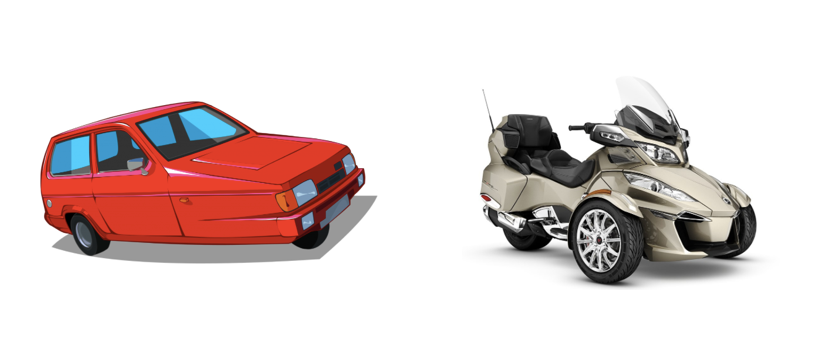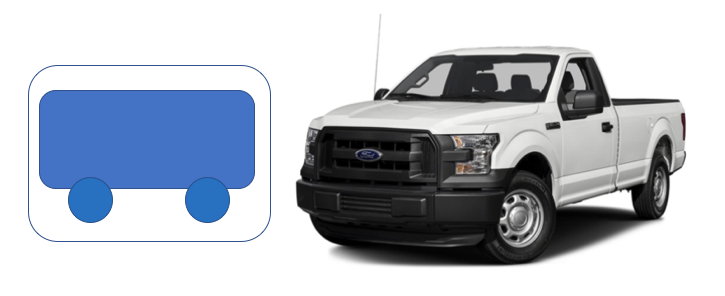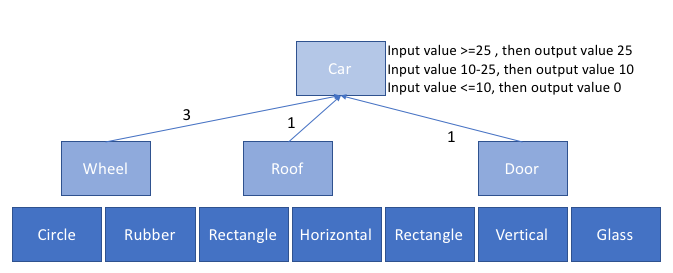Clues about how your brain might work (I)
Did it ever struck you how easily you recognize objects that you have never seen before? If you see a new car (new brand, new model) you will immediately recognize this as a car, while it is the first time you see it.


You might have seen above cars before but even if you would have never seen them before, and despite the big difference in design, you will recognize both objects as a car.
This hints to the fact that if we recognize a car our brains do not compare it to a full shape of a remembered car but that it compares to sub-concepts of a car. One of these sub-concepts could be that it needs to have 4 wheels. That would mean that an object with 3 wheels is not a car.


However the above object on the left would still be recognized as a car. Not a great car (a Robin Reliant), but still a car. So, an object with 3 wheels is still a car? Not always, because I am sure you will label the above right object as a motorcycle.
So, when does our brain label a 3 wheel vehicle a car or a motorcycle?
I have shown below pictogrammes to different people.


The pictograms were shown separately and starting with the left one. The question at each pictogram was to tell me what the pictogram represented.
At pictogram 1 the subjects had no clue. At pictogram 2 the answer was almost immediately ‘a car or a bus’. The answer was even more convincing at pictogram 3. (Seemingly even 2 wheels can do!)
I did the same exercise with below pictograms.


Here the answer on pictogram no.2 was far less convincing: ‘a car?’. Even pictogram 3 did not convince fully that this was a car.


Our minds label below objects with the same name: a car, while they could not be more different


Not a real shock but still it hides some very interesting clues about the working of our brain.


When does the pictogram ‘car’ stops being a car (see above row of pictograms)? There is somewhere in this sequence that the brain stops to label the object a car.
Let’s return to the pictograms that resulted in the recognition of a car.


In pictogram 1 the simplest sub-concepts we recognize here is a circle and a rectangle and a connection between the circle and the rectangle (and of course the color blue).
In pictogram 2 we add only one circle and seemingly these two circles now suddenly trigger a next sub-concept: wheels. The two circles are not enough to trigger the subconcept ‘wheel’, since the most right pictogram in fig 7 contains as well two circles but it is not generating the sub-concept ‘wheel’. Seemingly distance between the circles and the location of the two circles help to generate the sub-concept ‘wheel’. So, ‘wheel’ is only generated by the input of: 2 circles at a certain distance and location. Now, we have two wheels and a rectangle and this feeds in a next level of recognition and that level pulls up the label ‘car’. That label is not pulled up if we feed that level with two circles and a triangle. Seemingly, two circles at a certain distance below a triangle do not generate the label ‘wheels’.
I wrote earlier that the triangle with two circles did create some confusion and the label ‘car’ was less convincing than the two circles and a rectangle did. So this indicates that the threshold has 3 levels:
- no label/concept generated > no signal generated
2. maybe a label/concept generated > weak signal generated
3. definitively a label/concept generated > strong signal generated
A schematic representation could look as follows


Recognition in our brain must take place on different levels. The lowest level is probably just recognizing basic form and material (and color) that together will generate a sub-concept like a wheel and a door. These sub-concepts than signal to a higher level where the recognition takes place of compounded sub-concepts, like a car. I assume here that the circle and rubber at the lowest level was enough to pass the threshold to trigger the label/signal ‘wheel’ at the next level. I also assume here that seeing a wheel, a roof and a door (adding up to an input signal of 5) is not enough to trigger in the next level the label ‘car’ and send out a strong ‘car’ signal. So, in this scheme seeing a wheel, a roof and a door will not lead to the recognition of a car. If more elements of a car however arrive in the compounded sub-concept level the input value starts to grow. At 10 (arbitrary value) the output signal of 10 of the compounded sub-concept level goes out and this is not a confirmative ‘car’ but might trigger the question ‘a car?’. At an input signal stronger than 25 a real confirmative signal ‘car’ is send out further in the brain and the car is recognized. The recognition in itself does not do anything. If we recognize a car it is not that a picture of the car is send around in the brain. What the recognition does is that the network responsible for the memory of the concept car send a strong signal in the brain and that this make other memory networks fire. For instance the network for the word ‘car’ might fire. Associated concepts to the concept ‘car’ might fire as well like highway, speed, petrol,…etc. If the concept ‘car’ triggers the concept ‘Ford F250’ it is clear that the basic subconcepts of a car do not suffice but that specific subconcept of the Ford F250 need to be present as well for the network/concept Ford F250 to fire.
The interesting thing is that most probably not only signals climb the levels but that signals from higher levels go back in lower levels. If the car is recognized, that signal can confirm other lower level concepts that were not confirmed yet.
Please read below:

I guess the word FRIENDSHIP appeared earlier in your brain then that you had identified the last letter. The FRIENDSHI was sufficient to trigger the word FRIENDSHIP which as a result decided on the last letter ‘P’.
Above, we have identified three levels of recognition:
- Basic forms
- Sub-concepts
- Compounded sub-concepts
But nothing stops up to build more levels of recognition on top this. In other words, is the ‘car’ signal going to other higher levels?
A game that we play regularly in the family (mainly during long car trips) is the game that somebody starts with a word and that the next person then mentions an associated word and the next person after that an associated word to the previous word. The aim is to come back to the original word and the person who does this is the winner. There are a few rules. You can only mention an associated word that is ‘one step’ away from the previous one (always a debate) and a return to the original word counts only as a victory if this happens after at least 5 steps. Last, the associations need to be a subject or color.
So, the sequence could be:
car-highway-road-traffic-police-fine-money-bank-loan-debt-poverty-hunger-…
The fact that I am able to make these associations means that when the word ‘car’ enters my brain it triggers all other concepts that are directly associated with a car. It will trigger not only other concepts but also sub-concepts of the car, since the sequence could also have been:
car-wheel-bicycle-race-tour de France-Paris-Eiffel tower-steel-…
But how does this work in the brain? If I see a car does it trigger all the associated concepts of a car and will it create a waterfall of:
wheel, bicycle, race, tour de France, Paris, Eiffel tower steel
in parallel with:
highway, road, traffic, police, fine, money, bank, loan, debt, poverty, hunger


Though it is useful to be able to make all these associations consciously, it would be quite a chaos in the brain if all these concepts would become active in the brain (like falling domino’s) if a car would be observed. So, when do they become active?
I will talk about that more in the next article: Clues about how your brain might work (II); Waterways
